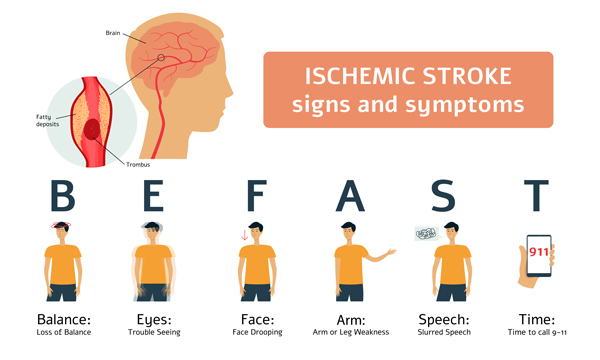
Listen to this article - English & Spanish
Women and Stroke
UNIQUE SYMPTOMS

According to the American Stroke Association, stroke is the third leading cause of death for women. In comparison, stroke is the fifth leading cause of death for men. In addition, strokes are on the rise in young women by up to 40%. While many common stroke symptoms are shared by men and women alike, there are some additional symptoms that are unique to women.
COMMON STROKE SYMPTOMS
Some of the most common stroke symptoms that both men and women experience include:
- Sudden numbness or weakness in the face, arms, or legs, especially on one side of the body
- Sudden confusion, trouble speaking or understanding;
- Sudden trouble seeing in one or both eyes
- Sudden trouble walking, dizziness, loss of balance or coordination
- Sudden severe headache with no known cause
UNIQUE STROKE SYMPTOMS IN WOMEN
The American Stroke Association reports that women can have symptoms that are different from the warning signs more commonly associated with stroke. Unfortunately, these unique symptoms are sometimes not recognized as a stroke and obtaining timely
treatment is often delayed. Women can experience:
- Loss of consciousness or fainting
- General weakness
- Shortness of breath
- Confusion, unresponsiveness, or disorientation
- Sudden behavioral change
- Agitation
- Hallucination
- Nausea or vomiting
- Pain
- Seizures
- Hiccups
UNIQUE STROKE RISK FACTORS IN WOMEN
In addition to the general risk factors for stroke which include family history, high blood pressure, high cholesterol, diabetes, smoking, lack of exercise, and being overweight, women are faced with additional risk factors unique to them. These
can include:
Taking birth control pills – although it occurs in a relatively small percentage of women, taking the birth control pill can cause blood clots related to strokes. This does not mean you need to stop taking the pill, but always discuss your
health history with your doctor, especially if you have other risk factors such as high blood pressure, smoking, age, or diabetes.
Being pregnant – Stroke risk can increase during a normal pregnancy due to natural changes in the body such as increased blood pressure and stress on the heart.
Using Hormone Replacement Therapy (HRT) – A combined hormone therapy of progestin and estrogen, to relieve menopausal symptoms can increase risk.
Suffering from migraine headaches – Migraine headaches are more common in women than men. Migraines are vascular headaches that cause blood vessels to spasm. These spasms are believed to increase the risk of strokes since they can cause
blood flow loss to the brain and create clotting. Having migraine headaches can increase a woman’s stroke risk two and a half times.
IF YOU SUSPECT STROKE IN YOURSELF OR A LOVED ONE, BEFAST AND DIAL 9-1-1.

- B –Balance: Loss of balance
- E – Eyes: Trouble seeing
- F – Face: Face drooping
- A – Arm or leg weakness
- S – Speech: Slurred speach
- T – Time: Time to call 9-1-1
The most successful outcomes are seen in patients who received treatment within the first three hours of experiencing symptoms.
